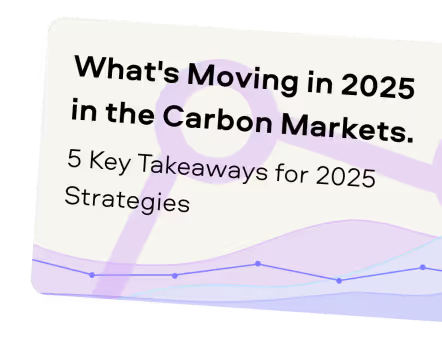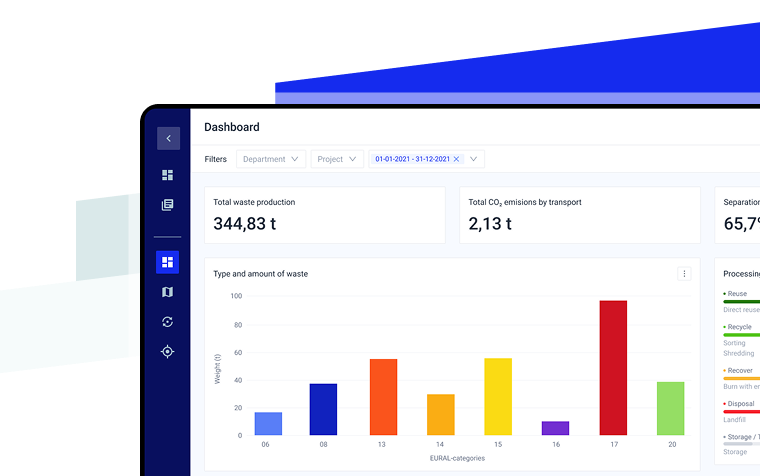“Over the years we’ve invested significantly in our field data team - focusing on producing trusted ratings. While this ensures the accuracy of our Ratings, it doesn’t allow the scale across the thousands of projects that buyers are considering.”
For more information on carbon credit procurement trends, read our "Key Takeaways for 2025" article. We share five, data-backed tips to improve your procurement strategy.

One more thing: Connect to Supply customers also get access to the rest of Sylvera's tools. That means you can easily see project ratings and evaluate an individual project's strengths, procure quality carbon credits, and even monitor project activity (particularly if you’ve invested at the pre-issuance stage.)
Book a free demo of Sylvera to see our platform's procurement and reporting features in action.
The 2025 Waste Compliance Landscape—What Actually Applies to Enterprises
For a long time, the waste management sector was known for its lack of transparency and light oversight. That is changing rapidly. Over the past few years, regulatory agencies have tightened waste and recycling requirements across Europe and beyond. By 2025, many enterprises will face stricter compliance obligations.
Here’s what applies, and when:
- Corporate Sustainability Reporting Directive / ESRS E5: Requires detailed reporting on resource use and waste disposal, including waste outflows, recovery rates, treatment types, hazardous materials, and complete audit trails.
✅ Applies if your company falls under CSRD (large or listed in the EU) or if you report Scope 3 emissions.
- ISO 14001: Demands robust environmental management systems, document control, and evidence of continual improvement.
✅ Applies if you are already certified, pursuing certification, or want to demonstrate best practice.
- Extended Producer Responsibility (EU): Requires businesses placing products on the market to remain responsible for the resulting waste.
✅ Applies if you place packaging, plastics, or other products on the EU market — whether you manufacture or import them. Mandatory for six product groups: car tyres & end-of-life vehicles, batteries & accumulators, electrical and electronic equipment, textiles, packaging, and single-use plastics.
- Waste Electrical and Electronic Equipment Directive (WEEE): Requires classification, manifests, and proof of proper treatment for electronics.
✅ Applies if you produce or sell electronics such as fridges, computers, or mobile phones.
- International Waste Shipment Regulation (IWSR):
✅ Applies if your waste is transported internationally.
- Resource Conservation and Recovery Act (RCRA): U.S. legislation that governs hazardous waste from “cradle to grave” — including generation, transportation, treatment, storage, and disposal.
✅ Applies if you are a hazardous waste generator based in the U.S.
RCRA, a long with other key environmental statutes such as the Clean Air Act and Superfund, was enacted by Congress, which plays a central role in shaping federal waste management regulations in the United States.
Depending on your footprint, one or more of these frameworks may apply to your operations. However, knowing the regulations is one thing; proving compliance requires capturing the correct data. The following sections highlight the exact data points you’ll need to ensure compliance.
Storage, Handling, and Transportation
Proper storage, handling, and transportation of waste are vital to ensuring safety and regulatory compliance at every facility. All containers used for waste storage and transport must be compatible with the specific contents, designed to prevent spills and minimise the risk of accidents.
Facilities are required to maintain accurate records of waste generated, stored, and disposed of, ensuring that every step in the waste management process is documented and traceable. It’s essential that all parties involved in waste management—whether internal staff or external contractors—are adequately trained in safe handling procedures and familiar with both federal and state regulations.
Regular compliance evaluation inspections help identify potential hazards, verify that storage and transport practices meet regulatory standards, and ensure that facilities are operating safely.
By following best practices for handling and transporting hazardous and non-hazardous wastes, businesses can prevent environmental contamination, protect human health, and maintain compliance with all applicable laws.
Hazardous Waste Management
Managing hazardous waste requires a systematic approach to identification, classification, and disposal, as these materials pose significant risks to both human health and the environment.
Under the RCRA and related federal and state regulations, businesses are responsible for ensuring that hazardous waste—such as lead, mercury, and pesticides—is properly managed from the point of generation through to final disposal.
This involves using advanced technology for accurate waste tracking, implementing rigorous procedures for handling and storage, and conducting regular compliance evaluation inspections to verify adherence to regulatory requirements.
Facilities must ensure that all staff are trained in hazardous waste management protocols and that detailed records are kept for every stage of the process. By prioritising the safe and compliant management of hazardous wastes, businesses not only fulfil their regulatory responsibilities but also minimise environmental risks, protect public health, and enhance their company’s reputation for responsible waste management.
The Audit-Ready Data You Must Capture (and Keep)
To meet regulatory requirements and prepare for a compliance evaluation inspection, companies must structure their records into a waste data management plan that captures all critical details to prepare for a case development inspection. Maintaining an up-to-date compliance status requires regular monitoring, reporting, and documentation to demonstrate ongoing adherence to waste management regulations.
The following data points are essential for auditability and compliance:
- Waste Outflows & Materials: EWC code/material, weight & unit, site of origin, date, hazardous (yes/no), radioactive (yes/no)
- Treatment & Destination: Treatment type (recycling, landfill, recovery, etc.), processor name, disposal facility address/country
- Transport & Logistics: Transporter name, transport distance (km), cross-border shipment documents
- Packaging & EPR: Packaging type/material, placed on market vs. collected, financial contributions to compliance schemes
Capturing these fields is the foundation of effective compliance waste reporting. However, raw data isn’t enough—to withstand audits, companies need to demonstrate accuracy and reliability.
Verification & Auditability—From “Data Collected” to “Data You Can Defend”
Collecting data is only the first step. To withstand a compliance evaluation or audit, you must be able to prove the accuracy and reliability of your records. All data collection and verification processes should be conducted in a manner that meets regulatory requirements and supports environmental protection.
Data Quality Rules
- Completeness – no missing fields
- Consistency – units, naming, coding standards
- Accuracy – ticket ↔ invoice alignment; weighbridge checks
- Timeliness – month-end cut-offs
- Uniqueness – no duplicate tickets
- Lineage – every record linked back to a source file
Anomaly Detection
Configure alerts for:
- More than ±20–30% variance month to month
- Missing hazardous waste compliance fields
- Negative or zero weights
- Long or illogical distances for transporting waste
Applying these checks reduces the risk of environmental harm, improper waste management, and costly legal repercussions. It ensures your data is not just collected, but defensible under audit—something geoFluxus’ data automation and verification workflows deliver by default.
Evidence & Documentation Map (What Auditors Expect)
Auditors require evidence-based reporting, which means showing how every data point links to waste and recycling regulations and federal regulations. Auditors may also require documentation tied to specific sections of environmental laws, such as Section 3007 of RCRA, which grants authority for information requests and regulatory oversight.
Source Evidence
- Invoices
- Tickets and manifests
- Weighbridge slips
- Transport documents
- Contracts & SLAs
Linking & Retention
- Maintain accurate records for ±7 years (dependent on your country)
- Apply record-keeping policies that support compliance requirements
- Manage confidential business information responsibly
- Ensure version history and access controls
Document linking and retention are central to waste compliance management, ensuring every datapoint can be traced back to its origin. With geoFluxus, these workflows are automated — every record linked, every change tracked, and complete audit trails always ready for inspection.
Sample Folder Structure
Year / Site / Stream / Processor / Manifest_ID /
→ tickets.pdf
→ invoice.pdf
→ certificate.pdf
→ README (owner + last audit date)
Once evidence is mapped, the next step is using the same dataset for compliance KPIs that support both audits and performance.
KPIs required for Compliance, Reporting, and Performance
Now that you have all the data points, you can organise them according to what is required for reporting—an overview per the topic or directive of what’s required. Enterprises must track a variety of compliance activities and KPIs to meet the requirements of different waste management frameworks, including those related to air, oil pollution, waste, and water.
Corporate Sustainability Reporting Directive (CSRD) / ESRS E5
✅ Applies if your company is large or listed in the EU.
You must report on:
- Waste outflows (total, by type/material, by site)
- Hazardous vs. non-hazardous waste
- Radioactive waste
- Treatment types (recycling, recovery, incineration, landfill)
- Recovery rates (% recycled or reused)
- Destination (processor, country)
ISO 14001
✅ ISO 14001 applies if you are certified, pursuing certification, or want to demonstrate best practice.
You must report and maintain:
- Waste outflows (total, by type/material, hazardous, by site)
- Treatment types (recycling, recovery, incineration, landfill)
- Records of continual improvement (waste-reduction plan, KPIs, corrective actions)
- Operational controls (procedures for waste storage, handling, labelling)
- Evidence of compliance (tickets, permits, invoices, contracts, employee training)
Extended Producer Responsibility (EPR) (EU)
✅ Applies if you place packaging or plastic products on the EU market—whether you manufacture or import them. Mandatory for: car tyres & scrap cars, batteries & accumulators, electrical & electronic equipment, textiles, packaging, disposable plastics.
You must report on:
- Packaging placed on the market (by type and material: paper, plastic, glass, metal, textiles, etc.)
- Packaging/waste collected (by type/material and country)
- Producer responsibility identifiers (scheme IDs, registration numbers)
- Recovery/recycling performance (collected vs placed on market)
- Financial contributions to compliance schemes (e.g., eco-fees, rebates)
Waste Electrical and Electronic Equipment Directive (WEEE)
✅ Applies if you manufacture, distribute, or sell electrical and electronic equipment (e.g., computers, fridges, mobile phones). EU, national laws, and general waste disposal regulations require that you ensure proper collection and treatment. Specific items, such as electronic equipment, must be properly handled, recycled, or disposed of in accordance with WEEE regulations.
You must maintain:
- Amount of electrical and electronic equipment sold
- Proof of appropriate treatment
- Proof of providing or financing a collection service
- Registration with national WEEE systems
International Waste Shipment Regulation (IWSR)
✅ Applies if your waste is transported across national borders for treatment, disposal, or recovery.
Note: recycling and reuse are not yet included but are expected to be added by mid-2026.
You must provide:
- Waste origin
- Waste composition
- Treatment types (recycling, recovery, incineration, landfill)
- Cross-border certificates and documents (notifications, consents)
- Companies or authorities involved (producer, collector, processor)
- Contracts with involved parties
Resource Conservation and Recovery Act (RCRA)
✅ Applies if you generate hazardous waste in the U.S.
The Resource Conservation and Recovery Act (RCRA) sets specific requirements for hazardous waste generators, including limits on the amount of hazardous waste they can accumulate at a site. Generators must classify waste based on its chemical and physical properties to ensure proper handling and regulatory compliance. Hazardous waste must be stored in compatible containers that meet safety standards and are properly labelled. All procedures must be designed to ensure safety for workers, the public, and the environment. When you transport hazardous waste, you must follow federal laws and maintain proper documentation. Treatment, storage, and disposal facilities must be properly located and housed in suitable buildings to meet regulatory standards and protect the environment.
For all hazardous waste, you must provide:
- Waste outflows (total, composition, by type/material, by site)
- Treatment types (recycling, recovery, incineration, landfill)
- Companies or authorities involved (producer, collector, processor)
Beyond compliance reporting and towards valuable insights for performance
Meeting compliance requirements is essential, but the same data can also drive operational and environmental stewardship performance. With the increasing volume of hazardous and non-hazardous waste, enterprises must continuously adapt their compliance strategies and performance metrics. By tracking the right KPIs, you can identify efficiencies, reduce costs, and demonstrate environmental leadership.
Recommended KPIs include:
- Recycling rate – Aim for 85%+
- Separation rate – Aim for 85%+ (higher rates boost reuse of materials)
- Landfill & incineration rate – Keep below 5%
- Total CO₂ from waste – Processing + transport (supports climate reporting)
- €/tonne – Cost of processing (spot efficiencies across companies and sites)
Where Compliance Breaks in Multi-Country Operations
Tracking KPIs at a single site is manageable, but things become complicated when operations span international borders. For companies operating across multiple states, navigating varying regulatory requirements adds another layer of complexity to compliance efforts. Additionally, it is crucial to monitor regulatory changes at the federal, state, and local levels to ensure ongoing compliance in all jurisdictions. Companies handling hazardous waste often keep reasonable control, but other waste streams are more complex to track across borders. Common pitfalls include:
- Varying national schemas & languages — Different reporting templates, terminology, and units of measure can lead to misclassification or double-counting.
- Cross-border paperwork — Under IWSR and the Basel Convention, missing certificates, incomplete routing logs, or unsigned facility acceptances can halt shipments and trigger penalties.
- Inconsistent vendor contracts — Processor and transporter contracts often lack clauses on data provision, leaving companies chasing documents past deadlines and exposed to audit risk.
Controls & Processes — Your Compliance Checklist
Compliance isn’t luck. Auditors expect to see controls and processes that keep data reliable year after year. Put these in place:
- Governance (RACI) — Assign clear ownership: QHSE for data definitions, Sustainability for ESRS mapping, Procurement for vendor contracts, Finance for cost validation, IT/Data for integrations, Compliance for audit trails.
- Vendor data contracts — Bake data quality into contracts: required fields (EWC code, weight, treatment type), format, submission cadence, and audit rights. No more chasing missing or inconsistent files.
- Month-end close — Treat waste data like financial data: cut-off dates, reconcile tickets vs. invoices, document exceptions, and require sign-offs. Keeps reporting timely and complete.
- Training & SOPs — Train staff not just in operations, but in compliance (hazardous handling, documentation, incident reporting). Back this with standard operating procedures.
- System controls — Enforce compliance with tech: role-based access, version control, automated backups, disaster recovery, and periodic tests of critical controls.
💡 With geoFluxus, all these controls are built in by design — every contract, ticket, and audit trail linked automatically. That means fewer manual checks, less admin chasing, and confidence that your data is always inspection-ready, across every site and country.
👉 Instead of firefighting, you gain a compliance process that is predictable, auditable, and scalable — and a competitive edge in sustainability reporting.
Embedding these controls enables the development of resilient systems for environmental stewardship and waste compliance, whether at a single site or across multiple countries.
Common Pitfalls (and How to Avoid Them)
With so many moving parts, it’s easy to slip up when it comes to waste disposal regulations. These are the mistakes we see most often — and how to steer clear:
- No verifiable evidence — Regulators want proof. Always link figures to tickets, invoices, and certificates so data stands up to audit.
- Tracking tonnes only — Reporting volume isn’t enough. Show treatment (landfill, recycling, recovery) and processor details for ESRS/ISO compliance.
- Skipping verification rules — Without checks for completeness, accuracy, and anomalies, minor errors snowball. Automate cross-checks and duplicate detection.
- Vendor lock-in — Some vendors restrict data access. Negotiate contracts that guarantee usable data rights, and benchmark performance (€/tonne, recycling rates).
- Ignoring transport CO₂ — Low-cost processing isn’t sustainable if waste travels hundreds of km. Balance cost, compliance, and emissions.
- Neglecting groundwater wells — Failing to properly monitor and maintain groundwater wells in your monitoring systems can lead to compliance violations and environmental risks.
Avoiding these mistakes unlocks the real value of compliance: predictable processes and reduced risk.
Conclusion
Waste compliance in 2025 is about more than meeting checklists — it’s about data, evidence, and accountability. Enterprises must comply with evolving waste regulations and federal and state requirements to avoid non compliance , while also protecting human health, showing environmental responsibility, and conserving natural resources.
With the right systems in place, even complex tasks like managing hazardous waste, coordinating with waste transporters, and ensuring proper waste disposal at licensed facilities become part of a predictable, auditable process.
By embedding sustainable practices, clear compliance strategies, and robust record keeping into your waste management plan, organisations reduce the risk of financial penalties and environmental contamination while ensuring that all waste is managed safely and contributing positively to sustainable practices.
FAQs
What is waste compliance?
Following all applicable laws and standards for the generation, storage, transport, treatment, recovery, and final disposal of waste — and proving it with audit-ready records. Typical frameworks include CSRD/ESRS (E5), ISO 14001, EU EPR schemes, hazardous waste transporters under WEEE, cross-border rules under IWSR/Basel, and (for U.S. sites) RCRA.
What are the 5 rules of waste management?
Often presented as the “5 Rs” (a sustainability principle, not a legal rule): Refuse, Reduce, Reuse, Repurpose/Repair, and Recycle (sometimes Recover energy is included as a 6th “R”).
What are the 4 types of waste treatment?
Waste treatment is often simplified into four main categories:Disposal — landfill or incineration without energy recoveryRecovery — incineration with energy recovery (e.g., waste-to-energy)Recycling — converting waste into new raw materialsDirect Reuse — using materials again without significant processing
What are waste management regulations?
They are binding laws and schemes that define how solid waste, liquid waste, and hazardous waste must be handled, treated, and reported, aside from the reporting frameworks mentioned in the article. National legislation sets the detailed rules on what is permitted in practice. For example, in the Netherlands, the Landelijk Afvalbeheerplan (LAP) and Circulair Materialenplan (CMP) determine how waste may be processed, while other countries apply their own national plans, permits, and classifications. This means compliance requirements can vary significantly depending on where waste is generated.
How can enterprises manage waste compliance when operating across multiple countries?
Managing waste compliance across borders is challenging because each country uses different reporting templates, waste codes, thresholds, documentation rules, and transport regulations. Under frameworks like IWSR and the Basel Convention, missing or inconsistent paperwork can delay shipments or trigger penalties. The key to staying compliant is consolidating all waste data into a single, standardised system that applies uniform classification rules, provides audit trails, and centralises evidence such as tickets, manifests, and certificates. Platforms like geoFluxus automate this verification, ensure consistent data structures, and highlight gaps—helping enterprises avoid misclassification, double-counting, and cross-border reporting errors.









